The Irish Citizen Army, 1913-16: White, Larkin and Connolly
Published in 1913, 20th-century / Contemporary History, Features, Issue 2 (Mar/Apr 2006), Revolutionary Period 1912-23, Volume 14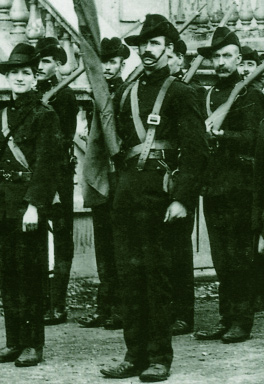
Captain James Robert (‘Jack’) White, first commander of the Irish Citizen Army. (George Morrison)
From the founding of the Irish Citizen Army (ICA) to Easter Week 1916 can be described as the organisation’s heroic period. It would survive the Rising by a further twenty years: until the Civil War in form and occasional actions and campaigns, then in suspended animation until 1934, and reviving for one more year before dissolving to form the nucleus of the left wing of the Dublin Labour Party, almost exactly 22 years after its foundation. Nonetheless, it would never regain the revolutionary purpose it had had under its first three commanders, Captain James Robert (‘Jack’) White, James Larkin and James Connolly. For its size, more has been written about the ICA in these two and a half years than about the Irish Volunteers. Published books include the histories of Seán O’Casey and R. M. Fox, the various lives of Larkin and Connolly, and the memoirs of Captain White, Frank Robbins and William O’Brien. That there were considerable strategic changes over this period is reflected in two facts. Not more than five of the 24 on the original army council elected on 22 March 1914 mobilised on Easter Monday two years later. The ICA’s two senior commandants in the Rising, James Connolly and Michael Mallin, had not been on the earlier body.
Ideological and practical roots
The ICA had two parents, one ideological and one practical. The first is represented by its title. Within the Socialist International, the affiliates expected that when they took state power, they would disband their states’ professional armies, pension off all but the most progressive of the officer caste and have a part-time army of citizens. It was an idea more utopian than revolutionary; one of its major advocates was the openly reformist Jean Jaures. The practical parent was rooted in the arming of strike pickets to defend themselves against attacks by strike-breakers and police. In America such groups packed firearms. However, in Ireland, before 1913, they carried hurley sticks. Such armed pickets appeared particularly in Jim Larkin’s disputes before and after the founding of the Irish Transport and General Workers’ Union (ITGWU), notably in Belfast, Cork, Wexford and, above all, in the Dublin Lockout of 1913, in which such formations took their fullest form.
A citizen army was invoked after the O’Connell Street baton charge at the end of August and by Jim Larkin during the following month. The old ICA member John Hanratty would recall how, one night in mid-October, about 500 strikers heard of a plan to mobilise an army of workers and went to the ITGWU’s estate at Croydon Park, Marino, registered their names and dispersed without anything happening afterwards. Then, on 13 November, when Larkin was released from prison, Connolly called again for a citizen army to be formed. This might have resulted merely in more hurley-wielding pickets had not the appeal been heard by Captain Jack White. A field marshal’s son and Boer War veteran, White had developed a vague form of Christian socialism. He had tried to mediate between the two sides in the Lockout in a body called the Citizens’ Committee, but had become increasingly pro-striker as he saw the attacks by armed strike-breakers and police. The day after Connolly’s call, White went to Croydon Park and offered the union his skills as an army officer and prospective organiser. He was introduced as such to a meeting of about 5,000, but only two dozen joined the new citizen army. Nonetheless, he enlisted them and began drilling from the end of the month. He expected the ICA to be the ITGWU under arms, but this was not popular with many of that union’s members, and became less possible after the union ended its struggle at the end of January 1914. The victorious employers victimised army members, but White maintained and added to the force so that it did not go the way of strikers’ militias in Cork and Wexford. By March 1914 it numbered about 50, or slightly less.
Irish Volunteers a barrier to growth
Besides victimisation and the reluctance of many ITGWU members to join, the ICA faced a further barrier to its growth. Its contemporary force, the Irish Volunteers, appealed to the resources of Irish nationalism against Britain, besides having more material resources in money, premises and trained officers. Above all, as Seán O’Casey remarked:
‘The old lingering tradition of the social inferiority of what were called the unskilled workers prompted the socially superior tradesmen to shy at an organisation which was entirely officered by men whom they thought to be socially inferior to themselves.’
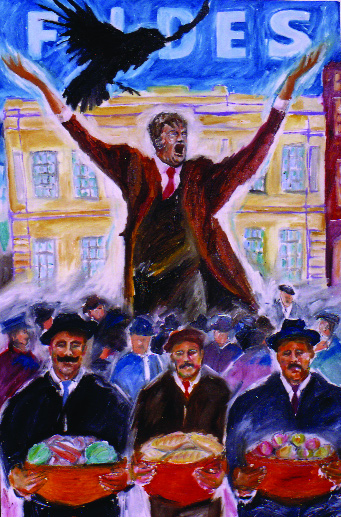
Jim Larkin-‘he proved to be the most committed of the ICA’s first three leaders’. (Caoimhghín í“ Croidheain)
This caste spirit infected even the workers’ leaders. Richard O’Carroll, who headed the Labour Party on Dublin Corporation, would die as an Irish Volunteer.
Though the Dublin workers had suffered a setback, they remained militant. On 13 March 1914, 200–300 demonstrated. Their march was attacked by the police and White was arrested. On his release, and at Seán O’Casey’s persuasion, he was confirmed in his belief that the ICA required more formal organisation to be effective. So, on 22 March, a conference gave the Irish Citizen Army a constitution and an army council, under White as chairman and with O’Casey as secretary.
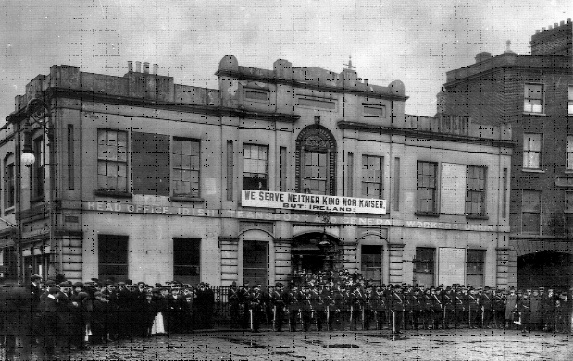
A contingent of the Irish Citizen Army parades (with Howth rifles) outside Liberty Hall in September 1914. The ICA participated in the Howth gun-running and kept some of the rifles, even though they were paid for by the other organisation, the Irish Volunteers. (George Morrison)
The council numbered 24 (nearly half the army membership), though probably some were elected less as active soldiers than for their influence. This was true of Thomas Foran, the ITGWU president, almost certainly true of the pacifist Francis Sheehy-Skeffington, and perhaps, at this time, true of Larkin, whom Connolly is said to have encouraged to join to keep him from introspection after the Lockout.
Frank Robbins talks of ‘the Socialist ideals expressed in the constitution of the Irish Citizen Army’. In fact, though it declared that its ‘first and last principle . . . is the avowal that the ownership of Ireland, moral and material, is vested of right in the people of Ireland’, the third clause made ‘one of its objects . . . to sink all differences of birth, property [author’s emphasis] and creed under the common name of the Irish people’. More significant was the clause, moved by Larkin, that ‘before being enrolled, every applicant must, if eligible, be a member of his trade union, such union to be recognised by the Irish Trade Union Congress’. Like the ITGWU, the ICA was a labour body, an organisation of workers rather than of socialists. Its ranks included many quite sophisticated socialists, but its training was military, not political.
White resigns; Larkin takes command
The constitution was published in a manifesto sent to Ireland’s nine largest towns, but even the centres of the ICA’s forerunners, Cork and Wexford, did not reply. The army remained restricted to Dublin. It seems that this failure caused White to try to affiliate the ICA as two units of the Irish Volunteers; his force could not beat them so it would join them. His first overtures were rejected by the Volunteers’ secretary, Bulmer Hobson. This did not deter him. Then his colleagues decided, five weeks after the constitutional conference, that they should challenge the Volunteers to debate their class nature. When this was agreed, White resigned. His reasons were given in a letter to the Evening Telegraph (5 May 1914). As this has never been quoted in any of the detailed histories of the ICA, it is repeated here:
‘Dear Sir,
With reference to a paragraph which appeared in some of this morning’s papers connecting my name with a challenge issued by the Citizen Army council to the provisional committee of the National Volunteers, I wish to state that I had nothing to do with it; in fact, I resigned from the chairmanship of the said council a week ago, doubtful of my power to prevent, and determined not to become involved in such a policy. In my opinion the all-important point is the speedy formation and equipment of a volunteer army implicitly or explicitly determined to achieve the independence and maintain the unity of Ireland, and I will not lift a finger to embarrass any body likely to work for this end.
For an “army council” which has not yet created an appreciable “army” to issue a challenge to the organisers of a strong and growing movement seems to me a little short of absurd. Nevertheless, I believe that the predominance of trades unionism over unionism is the line of least resistance to the unification of Ireland, and I shall work along that line myself whenever and wherever I get the chance.
I am yours etc.,
J.R. White, Captain.’
White became an organiser for the Volunteers and was succeeded by Jim Larkin. If Larkin had had to be talked into playing an active role, he showed no sign of it now. In his five months in command, he proved to be the most committed of the ICA’s first three leaders, probably of any of them. He had learnt from experiencing the Lockout that the union alone could not lead the workers to take state power. His political experience in Britain and Ireland made him sceptical about the role of any party. To build an organisation of armed workers seemed much more promising. The skeletal nature of its programme did not worry him any more than had that of his union. For him, and he was not alone, a labour organisation was bound to be a socialist one.
If Connolly had persuaded Larkin to participate, he must have regretted it at times. The new commander devoted himself to his army to the neglect of the union of which he remained secretary. The climax came in June 1914, when he tried to resign his union post and absented himself from the special meeting to debate this to lead 200 behind the Citizen Army banner to Wolfe Tone’s grave at Bodenstown. A subsequent meeting persuaded him to continue as secretary, but it was understood that he would take leave of absence from both union and army by going to the USA, allowing the situation to be clarified one way or another without too much friction. In the meantime, he continued to build the ICA. On 29 August his paper, the Irish Worker, announced that ‘we are about to reach 1,000 members’. According to O’Casey, the figure was achieved; it would never be exceeded. The figure could have been a typical Larkin exaggeration. Brendan Mac Giolla Choille quotes police reports tracing ICA strength for the following 5 October, when it was estimated at 60. However, these figures are taken from précised reports, there are discrepancies in the table and they clash with every other piece of evidence. Probably the higher figure was closer to the reality.
It would not have been Larkin alone, or even Larkin and his army council, that expanded their force. Probably it recruited a number of disillusioned Irish Volunteers. From 1 June, John Redmond’s Irish Party controlled the larger body, and this was a guarantee against any initiatives likely to go beyond the home rule perspective. From early August the division on the national question grew wider, since with the beginning of the First World War Redmond pledged the Volunteers’ support for the British war effort.
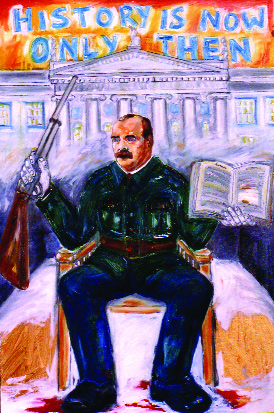
James Connolly-‘Of all the ICA leaders, his strategy is the most controversial’. (Caoimhghín í“ Croidheain)
This would have been a further reason for the nationally minded rank-and-file to defect to the one armed body consistent in its stand.
All this made it less likely that the ICA might apply to affiliate to the Volunteers. In any case, Larkin and O’Casey weren’t interested. The ICA cooperated with the Volunteers on occasion; they marched with them at Bodenstown and participated in the Howth gun-running (keeping some of the guns bought by the other organisation). Generally, they kept their distance. When they were furthest apart, in August or early September, O’Casey tried to get Constance Markievicz expelled as a member of the Volunteers’ associate organisation, Cumann na mBan. He had enough support to pass his proposal, but bungled his case and had to leave. Then, on 23 September 1914, Redmond pledged the Volunteers to serve the British war effort at the front. One tenth of their strength, about 9,000, repudiated him and reconstituted their own Irish Volunteers. Within a month, Larkin had left for America. The ICA had lost two major assets. Any recruits from the original Volunteers would have left it for the breakaway organisation.
The ICA was already under pressure from the British army.
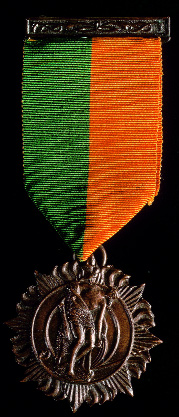
1916 medal of ICA veteran Robert de Coeur. (National Museum of Ireland)
In his statement in the Military Archives, James O’Shea stresses that body’s recruiting drive as the major drain on ICA members. Few would have been won by the war propaganda, apart from its treasurer, Brannigan (a.k.a. Braithwaite, a recruit from Orangeism). Of all the Irish, apart from unionists, ICA members had the least reason to believe it. Of all the Irish, however, they were most affected by such financial considerations as those of James Plunkett’s hero, Fitz:
‘[His wife] would have the allowance. The children would eat. The rent would be paid. In the Royal Army Service Corps he would learn to be a mechanic or a car driver. He would be sure of a job when he came back.’
Such an attitude was encouraged by the widespread belief that the war would be over by Christmas 1914.
James Connolly
These were the problems facing Larkin’s successor, James Connolly. Of all the ICA leaders, his strategy is the most controversial, though this springs more from opinion than alleged fact, on which there is considerable agreement between his opponents and supporters. The former are represented by O’Casey, in his Story of the Irish Citizen Army and, with more vitriol a quarter of a century later, in his autobiographical Drums under the windows. The latter are Connolly’s self-proclaimed heirs in the ITGWU, most notably, in their memoirs, his friend William O’Brien and the Easter Week veteran Frank Robbins. Both agree that Connolly was committed to building the ICA. In his Military Archives statement, Robbins declares: ‘[Connolly’s] official responsibility was by all means to keep the union alive, and his overriding desire to perfect the organisation of the Citizen Army’. O’Casey sees him as returning to White’s strategy and preparing the ICA for liquidation into the Volunteers. In his history, he declares:
‘Jim Connolly had stepped from the narrow byway of Irish socialism on to the broad and crowded highway of Irish nationalism. Irish Labour lost a leader.’
The ITGWU veterans would disagree. Celebrating Connolly’s participation in the national struggle, they conceal their own far less enthusiastic commitment after his death, leave their most conscious leader without any serious strategy, and vindicate their opponent, O’Casey, by default. There is a problem here. As with Larkin, it is necessary to examine Connolly’s acts as well as his public utterances in this period. However, whereas Larkin acted on impulse, surprising his closest colleagues, Connolly’s secrecy can be explained by his consistent strategy, of which he could explain only part.
His ‘overriding desire’ was to turn the imperialist war into a class war. He told Cathal O’Shannon: ‘I have missed the opportunity before, but I won’t miss it this time’. In this he conformed to the policy of the Socialist International passed at its 1907 Stuttgart congress:
‘Should war break out nonetheless, it is [the workers’] duty to intervene in order to bring it promptly to an end, and with all their strength to make use of the economic and political crisis created by the war to stir up the deepest strata of the people and precipitate the fall of capitalist domination.’
What has confused subsequent historians (aided by O’Casey) is that Connolly saw that the surest way to do this in the United Kingdom was through what would be, in part at least, a struggle for Irish national self-determination. He might have worked patiently for a specifically socialist revolution throughout the islands, but this would have been a doubtful prospect, and, anyway, it might not have occurred before the war ended. This approach has enabled historians to bracket him with the national defensists, who collaborated with their respective capitalist states, or even, as O’Casey does, as a deserter from socialism to bourgeois nationalism. In fact, he never deserted internationalism. In the Workers’ Voice (14 May 1932), the ICA veteran John O’Keefe reports Connolly asking participants in a debate as to the merits of nationalism versus internationalism: ‘How can you have one without the other?’ As a general statement this may not be true, but as a statement on Irish nationalism it did conform to Marx’s dictum that the Irish and the Poles are most internationalist when they are most nationalist.
A combination of nationalism and syndicalism
Connolly envisaged the ITGWU as the medium of this struggle. Though in charge of the ICA, he did not share Larkin’s illusions about it. Leon Trotsky describes the revolutionary consciousness of the Irish working class as combining nationalism and syndicalism, and Connolly raised this combination to the highest level. He had to fight to become the union’s acting secretary when Larkin departed. In this post he ran the ITGWU far more energetically than Larkin had after the Lockout. He gave it a properly constituted national leadership and organised new branches in Tralee and Killarney. From October 1915 he spearheaded the revival of Dublin working-class militancy by leading the strike of the dockers employed by the City of Dublin Shipping Company.
All this could do was create an environment for revolution. Connolly knew well that the union would not initiate such a move. Nonetheless, it would defend itself against attack from the colonial state. Accordingly, Connolly kept control of the Irish Worker and, when it was banned, the Workers’ Republic, using them to preach open sedition, even to the point of publishing articles in praise of the kaiser and defending the German war effort against Britain. This went further than was proper in encouraging illusions in a bourgeoisie, albeit the bourgeoisie of the enemy’s enemy. It was also central to a strategy that involved manipulating Connolly’s comrades. His problem was political isolation. After his death, his closest confidant, William O’Brien, would surrender to the idea of putting organisation first, regardless of its effectiveness or long-term aims. Like Larkin, Connolly had come to distrust political parties and this distrust became more notable. The propagandist Independent Labour Party of Ireland changed its name to the Socialist Party of Ireland in March 1915, and then disappeared for the rest of Connolly’s life. It is unmentioned in the Workers’ Republic. When he wanted to make propaganda, he held meetings in a Socialist Propaganda Society or in the union.
The Citizen Army fared better. Connolly kept it alive. He made Michael Mallin its chief-of-staff (its first) and Mallin improved training and discipline. The cost of this was the marginalisation of its army council. Numerically, it continued to decline. By spring 1916, its roll-book had 340 names; 200–250 mobilised in Easter Week. Connolly did not worry too much. When the ITGWU organised its Kerry branches, Connolly reassured the Volunteers that the ICA would not copy it. His articles on revolutionary warfare end with a call to join the Citizen Army or the Volunteers. Doubtless this alienated many, who came to the conclusion that O’Casey had been correct to resign for the reasons he did. In all, Connolly seems to have seen the ICA not, as J. Dunsmore Clarkson claims it was, as ‘the first Red Army in Europe’ but as a ‘Red Guard’, its nucleus.
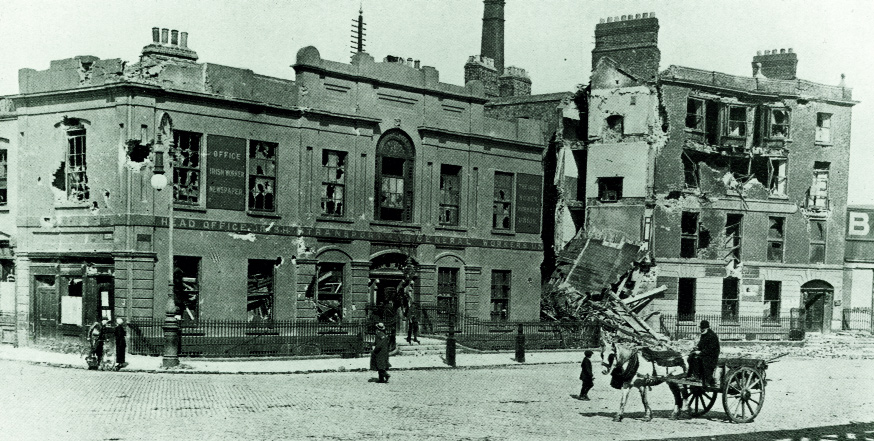
Liberty Hall in ruins after the Rising. (National Museum of Ireland)
In January 1916 Connolly had to change his strategy. He learned from the IRB’s military council, operating in secret within the Volunteers, that a rising was being planned for Easter. He could no longer try to provoke the British into retaliation. However, as late as the beginning of April, he held out hopes that the City of Dublin Shipping Company strike might provide cause for a clash between the British army and Dublin workers; had it continued until Easter, there would have been pickets of militant workers blocking the occupying force’s supply routes. This possibility was dashed by the action of the Seamen’s Union leadership in stopping the spread of the strike. The dockers returned to work and Connolly had either to fight on the Volunteers’ terms or abandon participation in the rising. He chose the first; the ICA and Volunteers fought as one army. White’s perspective had been achieved, but the result justified Connolly’s fear that the Citizen Army could not handle the politics of revolution. It was not the kiss of death for the ICA, but with the Rising its heroic age ended.
D. R. O’Connor Lysaght is a writer and historian.
Further reading:
R. M. Fox, History of the Irish Citizen Army (Dublin, 1944).
C. D. Greaves, The life and times of James Connolly (London, 1961).
S. O’Casey (‘P. Ó Cathasaigh’), The story of the Citizen Army (Dublin, 1919).
J. R. White, Misfit (London, 1930; Dublin 2005).
















